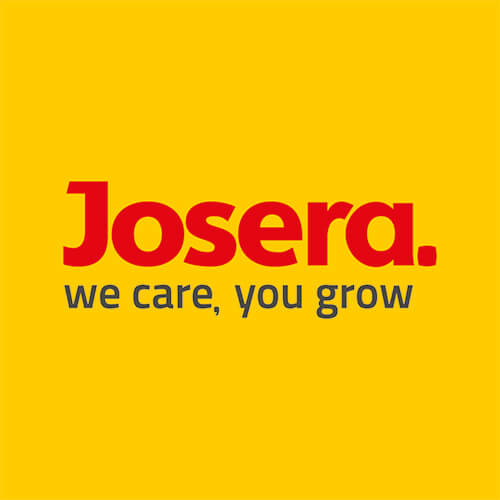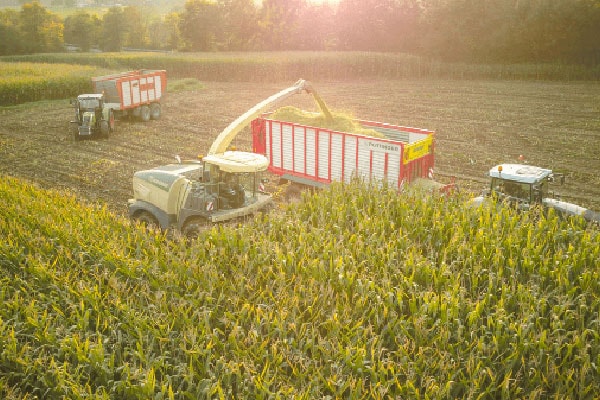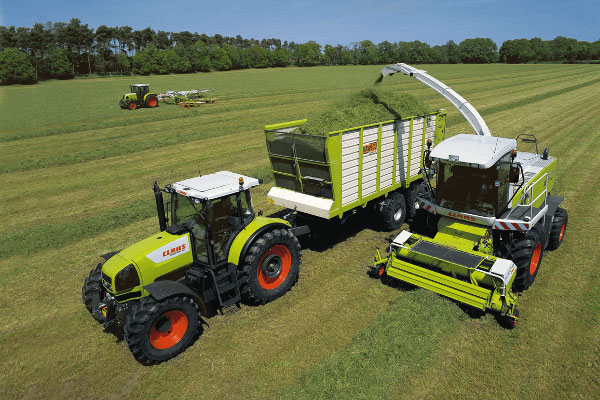Contents
- Why does the use of silage additives pay off?
- What is Josilac®?
- Which advantages do I have through the use of Josilac®?
- What are the areas of application for Josilac®?
- How do I apply Josilac® in practice?
- How do I determine the dry matter content?
- What do practitioners say regarding the use of silage additives?
- Josilac® in the grass harvest
- Josilac® in the maize harvest
- Faulty fermentation and reheating – what do I need to know?
Why does the use of silage additives pay off?
High-quality silages are defined by a very good dry matter intake and improved nutrient digestibility. The high intake of roughage increases milk production, promotes enduring animal health stability and thereby improves the lifetime performance of the cows. Therefore, the primary objectives of ensilaging are that the preserved feed:
- can be stored,
- is produced with low losses,
- and has a high feed value.
The quality of silage depends on the maturity of the ensiled material, the weather, and the dry matter and sugar content. Other important influencing factors are the buffer capacity, nitrate content and microorganism load. Some of these factors can be controlled by the farmer, thus the silage quality can be influenced with proper silage management (time of harvest, cutting height, wilting and field curing time, compaction and cover).
What is Josilac®?
The silage additive by JOSERA bears the name Josilac®. The Josilac® range contains five different biological silage additives.
Below you will find an overview of all five products:

* CCM = Corn-Cob-Mix; ** GPS = Ganzpflanzensilage
Josilac® with TURBO-Effect
Along with the controlled fermentation process, the acidification time is important to achieve superior silage nutritional quality with stable proteins. To reduce the pH-level as fast as possible, JOSERA offers you two homofermentative silage inoculants: Josilac® classic and Josilac® grass. Both contain the TURBO-Effect which ensures a fast and deep acidification of meadow and field grass as well as legumes.

Josilac® with SAFETY-Effect
High-quality and high-energy silages are often unstable and especially susceptable to reheating and mould formation during feed out. Yeasts and mould use the oxygen supply available once the clamp is opened to multiply explosively. The damage is usually extensive. The result is a high feed loss. In addition, mould and so called „hot spots“ can occur in deeper layers of the silage. Through present air channels (e.g. because of insufficient compression or of slow feed-out rates) oxygen can penetrate some meters into the silage stock. High production cows are particularly sensitive to warm and mouldy silage and feed intake is reduced. Moreover, mycotoxines produced by moulds negatively affect animal health. A good compaction and high feed-out rates (1.5 m/ week in winter, 2.5 m/week in summer) should be the goal. To gain more security in the high-quality feed, Josilac® with SAFETY-Effect should be used. It inhibits the formation of yeasts and mould and increases aerobe stability (see pictures below of treated and untreated silage maize, 2014). Therefore the feed is fresh and cool longer, as well as the feed losses have been reduced. The high quality and hygiene status of the silage remains stable.

Josilac® with SYMBIOSIS-Effect
The all-in-one solution can be generated by the combined effects of TURBO and SAFETY. With the SYMBIOSIS-Effect, JOSERA achieves more than the individual effects of TURBO and SAFETY. Symbiosis is characterized by an added value. The combination of mutual supporting and controlling homofermentative and heterofermentative lactic acid bacterial strains is unique. Elements out of the two different mechanisms are united. Because of this Josilac® with SYMBIOSIS-Effect can be utilized over a wide range of ensiled materials and a wide range of dry matter. This facilitates the farmer in making the right choice of silage inoculant and gives him more flexability.

What are the areas of application for Josilac®?
The use of a specific silage inoculant is based on several parameters:
- Type of ensilaged material
- Fermentation capability
- Buffer capacity
- Dry matter content
- Feed-out rate at the silage clamp
Different types of effects are considered. The TURBO-Effect should be used in cases of moderate or difficult fermentation, for example Josilac® classic or Josilac® grass. The more easily the ensiled material ferments and the higher the dry matter is, the more important is enhancing protection against reheating and mould formation. Here Josilac® ferm or Josilac® extra should be used with it‘s SAFETY-Effect.
For increased flexiblity to react to silage material, weather and harvest conditions, Josilac® combi with the SYMBIOSISEffect is the right choice. The graphic below shows through the colours (green, blue, yellow, orange) which effect and which Josilac® silage inoculant should be utilised under which condition.

How do I apply Josilac® in practice?
Josilac® silage inoculant is dissolved in water and distributed on the silage using suitable dosing equipment (see figure 1). The amount of water in the tank depends on the harvest volume, nozzle output and type of dosing equipment (see the table below for orientation). Example dosage for 3 g silage inoculant per ton of ensilaged material and a nozzle output of 0.3 l/min:
| Forage to be ensiled | Ton fresh matter yield per hectar and cut |
|---|---|
| Meadow 1st cut | 10 |
| Meadow 2nd cut | 8 |
| Mixed grass species | 10-15 |
| Whole crop silage | 12-25 |
| Maize silage | 50 |
| Harvest mass in tons per hour | Water volume in litres per 150 g bag |
|---|---|
| 20 | 45.0 |
| 40 | 22.5 |
| 60 | 15.0 |
| 100 | 9.0 |
| 120 | 7.5 |
| 180 | 5.0 |
For field choppers there is the concentrate (ULV) dosing device (see figure 2). The dosing device can be continuously adjusted by using a display. The output is 15 ml – 100 ml/min. It is delivered with a special water compressing air nozzle for the nebulization of the silage inoculant concentrate. Therefore, a compressor (from the field chopper) for the compressed air supply is necessary. Especially during the harvest of maize silage, there are high harvest outputs together with higher logistics expenditures. In this case you should use a ULV-device to use the silage inoculants with an exact amount of water.

Fig. 1: Standard dosing device

Fig. 2: ULV dosing device
Johannes Tröndle also uses a dosing device from JOSERA. Watch the video here!
What do practitioners say regarding the use of silage additives:
The Timmermann farm from the Rendsburg-Eckenförde district (Germany):
“The use of Josilac® combi has paid off; we are highly satisfied with the result. The second cut displays values which would really be demanded for the first cut. Due to the use of JOSERA silage additives, reheating is effectively prevented, even in the feed alley. In this way, the animals have a high feed intake which is also reflected in excellent milking yield.”
The Lietzow farm from the Havelland district (Germany):
“Some of the people in our team were of the opinion that silage additives are only beneficial to the salesman, and that as long as the weather remained fair, the use of silage additives was superfluous. However, the results provided us with a different picture. The difference was very clear to see. I have now prevailed within the team, and the second cut will also be brought in with Josilac.”
How do I determine the dry matter content?
| < 20 % | slight pressure, liquid runs out |
| 25 % | strong pressure, liquid runs out |
| 30 % | strong pressure, very little liquid runs out, hands become wet |
| 35 % | strong pressure, hands become wet |
| 40 % | strong pressure, hands become slightly wet |
| 45 % | strong pressure, hands only feel damp |
| > 45 % | strong pressure, hands remain dry |
Josilac® in the grass harvest
You can see how perfectly grass silage with Josilac® succeeds in the following video:
Josilac® in the maize harvest
Top-class maize silage isn’t a matter of chance – and with Josilac®, you can achieve just that! See more in the video.
Faulty fermentation and reheating – what do I need to know?
Ensiling conditions during the silage season are not always the same, and are not always ideal. Wet weather conditions and a low lactobacilli colonisation can quickly lead to faulty fermentation. Faulty fermentation causes …
- A loss of protein which therefore leads to poorer protein quality. This has effects on the ration costs, and also on the health of your animals and the quantity of the milk.
- Energy and dry matter losses and reduced feed intake. Therefore, less milk is generated at a higher cost.
Reheating is also a common problem. Reheating causes …
- Dry matter and energy losses. Therefore, less milk is generated at a higher cost.
- A lower feed intake and poorer digestibility.
- Poor feed hygiene
- A higher risk of mycotoxins.
In both cases, we recommend the use of our biological silage additives, as they are able to lower the pH value very quickly and substantially and can increase the aerobic stability to keep the feed fresh and cool for a long time. Are you uncertain about the quality of your silage, or aren’t sure whether your silage is ideal? In that case, simply contact us – we are happy to advise you on how to increase your silage quality and optimise your silage performance through on-site silo monitoring.
Do you have any further queries on the application of silage additives?
Simply write to us using the contact form or call us on +49 9371 – 940 0.
We are looking forward to your enquiry.
You might be interested in the following contents:
Effects of silage quality on feed costs and animal health!
Every year, when introducing grass and maize silage, it is important to achieve the best result in accordance with the weather conditions and the care and fertilisation measures as well as the work procedures.
Silage management – the path to optimal grass silage with Josilac
The forage is the most important component in the feeding of dairy cattle. Combined with high proportionate costs in BZA (agricultural industry full-cost accounting) in the area of dairy cattle…








